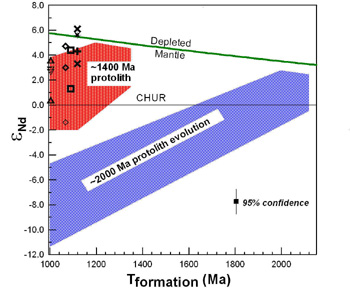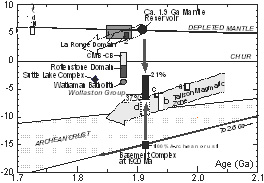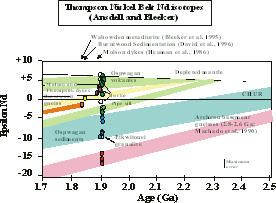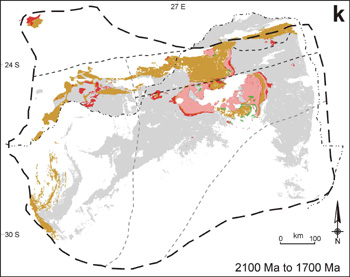Isotope applications in the Mesoproterozoic of southern Africa and Antarctica
|
 |
Isotopes play an important role in investigations of the origin and age of different sectors of the earth's crust. Prior to the break-up of the supercontinent of Gondwana (200 to 120 million years ago), the Falkland Islands were situated just off the south-east coast of South Africa. The similar age and Nd isotope composition of rocks from the Falkland Islands and ~1400 million year old crust in southern Africa provide supporting evidence for this fit.
Similar studies have been performed on rocks in Antarctica so as to constrain the assembly of fragments of crust prior to the formation of Gondwana at about 550 Ma.
For further information, contact Bruce Eglington |
Isotope applications in the Palaeoproterozoic of Canada
|
Research activities in Canada by staff of the SIL have concentrated on the Paleoproterozoic rocks of Saskatchewan and Manitoba, which are approximately 2 billion years old, and which was a time when the Earth's atmosphere and crustal recycling processes were changing from those prevalent in the first 2 billion years of Earth's history to those observed today. These rocks also contain significant concentrations of many metals. The work has recently culminated in the production of a review article that summarizes our present state-of-knowledge of the paleogeography and plate tectonic relationships, and a correlation chart that integrates geological data with isotope data to summarize the major geological events.
|
 |
 |
Nd isotope compositions of igneous and sedimentary rocks, in concert with the age of detrital and igneous zircons, have been particularly useful in unraveling the origin of the giant nickel deposits in Thompson, Manitoba, and the source of sedimentary material along the western margin of the Paleoproterozoic mountain belt in northern Saskatchewan. The Thompson nickel deposits, which were mapped by Dr. Bleeker of the Geological Survey of Canada, formed by the contamination of mantle-derived ultramafic magma by crustal rocks that were significantly older.
|
The source of the sediments in the Wollaston domain in northern Saskatchewan has been very controversial. Nd isotope compositions, determined by graduate student Hai Tran, emphasize that the sedimentary material was not derived solely from rivers sweeping eastwards across the Archean rocks of the Hearne craton, but must have included a significant amount of material (65 to 80%) from arc terranes that were colliding with the margin of the craton. This has led to new models for the evolution of this part of the Canadian Precambrian Shield, although there are a number of problems still to be resolved, particularly with regard to the interaction between crustal blocks and the mantle as continental collision proceeded. Hf and Pb isotope compositions of some of these rocks may resolve these issues.
For further information, contact Kevin Ansdell
|
Geochronological Evolution of the Archaean Kaapvaal Craton
|
 |
The Kaapvaal Craton of southern Africa is one of the oldest sectors of the earth, with rocks dating back to ~3.7 Ga. Major geological features from the area include the Barberton greenstone belt; the large Vredefort impact site; the Witwatersrand gold fields and the Bushveld layered igneous complex. A recent compilation of geochronological data as part of the international Kaapvaal Craton Project, has permitted staff of the SIL to illustrate the spatial distribution of rocks forming the craton as it developed.
For further information, contact Bruce Eglington |
|